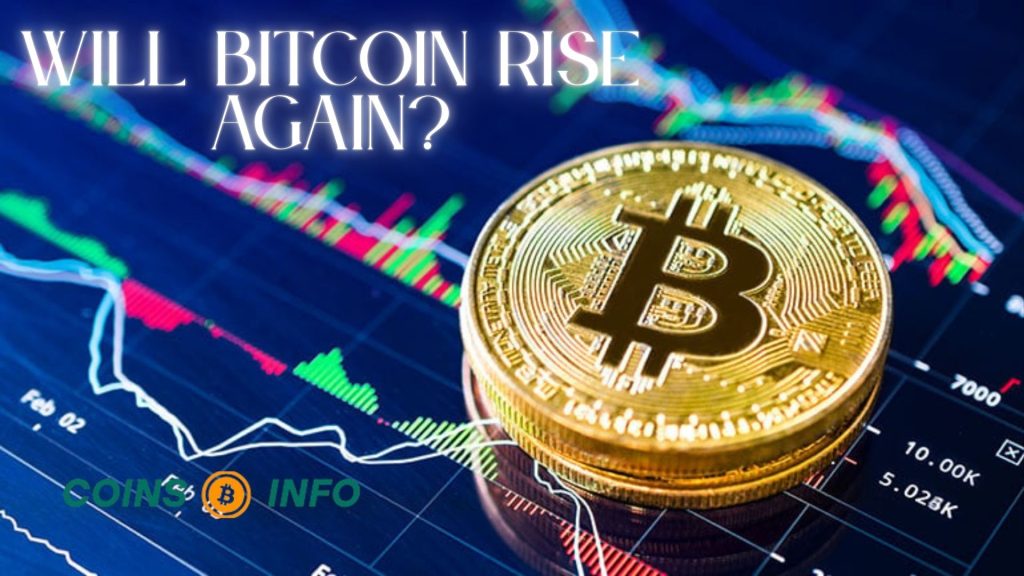Bitcoin Rise Again: Since its launch in 2009, Bitcoin, the first cryptocurrency, has gone through a turbulent period. Due to its dramatic price swings and subsequent sharp drops, Bitcoin has attracted both ardent supporters and doubtful detractors. “Will Bitcoin rise again?” is a timeless and relevant issue, particularly in light of changing global financial landscapes, legislative changes. technical advancements. Although no one can foresee the future with complete accuracy, a number of important elements can shed light on Bitcoin’s likelihood of rising once more.
Historical Resilience.
Bitcoin’s history is marked by repeated boom-and-bust cycles. By early 2015, Bitcoin had dropped below $200 from its peak of almost $1,000 in late 2013. It was deemed dead by many. However, Bitcoin rose to around $20,000 by 2017 before falling to about $3,000 in 2018. Once again, obituaries for Bitcoin filled headlines. Despite that, it surged to an all-time high of around $69,000 in November 2021. Even after a significant crash in 2022, Bitcoin rebounded again in 2023 and 2024, proving its resilience. This cyclical pattern, while volatile, underscores Bitcoin’s capacity to recover from major downturns.
The fundamental value proposition of Bitcoin—a decentralized, international, and deflationary digital asset—determines whether it may rise once again. In contrast to fiat currencies that are subject to inflationary monetary policies, its limited supply—21 million coins—makes it attractive. Bitcoin is seen by many investors as a digital equivalent of gold, a store of value during uncertain times, and a hedge against inflation.
Institutional Adoption and Market Sentiment.
A major driver of Bitcoin’s rise in recent years has been increasing institutional adoption. Financial giants like BlackRock, Fidelity, and Goldman Sachs have entered the crypto space, offering Bitcoin-related investment products or custodial services. In 2024, several spot Bitcoin ETFs were approved in the U.S., making it easier for mainstream investors to gain exposure to the asset. This legitimization has expanded Bitcoin’s reach beyond tech-savvy individuals to retirement funds, hedge funds, and retail investors.
Increased credibility, price stability, and liquidity are usually the results of institutional involvement. It also conveys assurance about Bitcoin’s long-term sustainability. Bitcoin’s market value and price may increase once more as more conventional financial institutions invest in the cryptocurrency. Public opinion also matters. Rekindled positive emotion might lead to waves of buying that push the price higher in the digital age, when stories spread quickly.
Regulatory Landscape.
Regulation is still one of the biggest unknowns surrounding Bitcoin’s future. Regulators and governments throughout the world are still debating how to handle cryptocurrencies. While some countries have welcomed Bitcoin by recognizing. as legal cash, such as El Salvador, others have implemented stringent regulations or outright prohibited it.
Recent patterns, however, indicate that a more beneficial regulatory structure might be taking shape. Despite its caution, the U.S. Securities and Exchange Commission (SEC) has authorized Bitcoin ETFs and provided more precise definitions of securities. A thorough regulatory framework for digital assets is what the Markets in Crypto-Assets (MiCA) regulation in Europe seeks to deliver. By taking these actions, Bitcoin may become more appealing to a wider spectrum of investors by lowering risk and uncertainty. However, excessively strict regulations may stifle investor confidence and impede growth, particularly in large economies like the US, China, or the EU. Whether or whether governments decide to regulate Bitcoin fairly and innovatively could determine whether or not it can rise once more.
Technological Developments and Network Growth.
Additionally, the Bitcoin network has kept changing. Although Bitcoin’s somewhat slow transaction speeds and energy usage are frequently criticized, these issues have been addressed in part by initiatives. The Lightning Network, a second-layer solution that makes transactions quick and affordable. The further advancement of financial apps and infrastructure based on Bitcoin may increase its usefulness and worth even more.
Additionally, network activity is still a crucial indicator. Price patterns are frequently correlated with the volume of transactions, the number of unique addresses, and the hash rate, which is a gauge of mining power. The argument for a fee rise is supported by an increasing hash rate, which indicates growing security and confidence in the network.
Macroeconomic Factors.
There is additionally to Bitcoin than meets the eye. More general macroeconomic factors have an impact on its price. Investor behavior is impacted by inflation, interest rates, currency devaluation, and geopolitical unrest. Alternative assets like Bitcoin can gain appeal when conventional markets falter or when inflation reduces purchasing power. On the other hand, investors may choose bonds or conventional stocks over speculative assets like Bitcoin if interest rates stay high and inflation levels off. The direction of the world economy will have a big impact on how Bitcoin develops in the future.
Conclusion.
Will Bitcoin increase once more, then? Although no result is assured, there are a number of signs that point to its likelihood. Bitcoin has a strong basis for future growth thanks to its historical tenacity, growing institutional support, clearer regulations, technological developments, and possible macroeconomic tailwinds.
But it’s important to recognize the risks. Threats from technology, regulatory surprises, and volatility remain. Bitcoin should be handled by investors with prudence, insight, and a long-term outlook. In summary, it has often been a losing idea to wager against Bitcoin. The forces behind it indicate that it is more than capable of rising again, possibly to new all-time highs, even though it might not move in a straight line.
